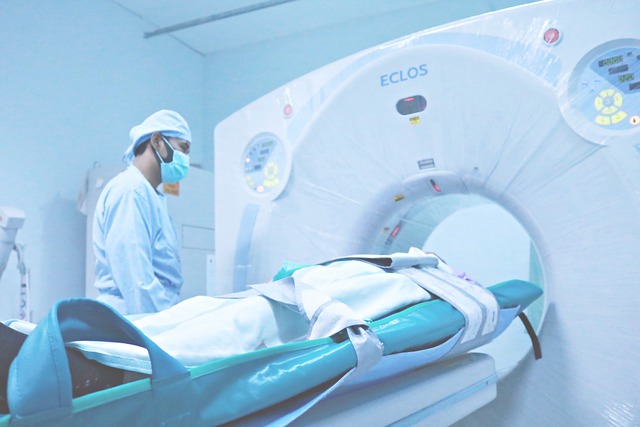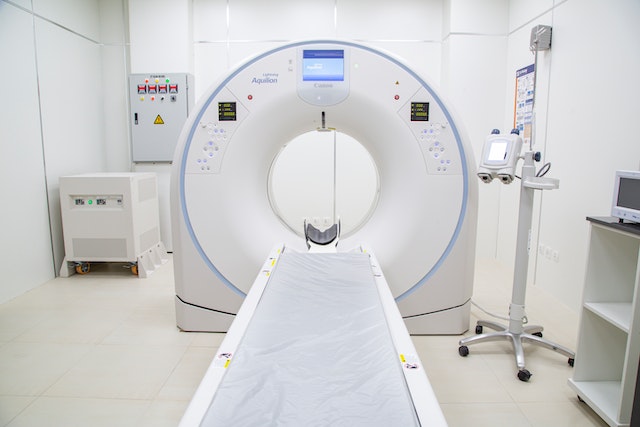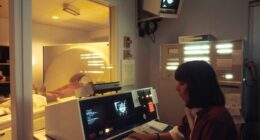MRI and CT are two of the most advanced medical imaging techniques used to diagnose a variety of health conditions. Both technologies have their unique features that make them useful in different situations.
What is MRI?
(Photo by Accuray on Unsplash )

MRI, which stands for Magnetic Resonance Imaging, is a non-invasive diagnostic test that uses strong magnetic fields and radio waves to create detailed images of the body’s internal structures. These images can be used to diagnose a wide range of medical conditions such as tumors, infections, and injuries.
During an MRI scan, the patient lies on a table that slides into a cylindrical machine. The machine creates powerful electromagnetic fields that cause protons in the body’s tissues to align with the field. Radio waves are then sent through the body which causes these protons to emit signals picked up by sensors in the scanner.
These signals are then processed by computer software to produce highly-detailed 3D images of organs, bones or soft tissue inside your body. Unlike X-rays or CT scans – which use ionizing radiation – an MRI does not expose patients to any harmful radiation making it safer for repeated examinations.
While MRIs have been around since the early 1980s, they’ve come a long way since their inception and now offer greater accuracy than ever before thanks to advances in technology and imaging software.
What is CT?
(Image by Mufid Majnun from Pixabay)

CT (Computed Tomography) is a medical imaging technique that uses X-rays and computer technology to create detailed images of the inside of the body. The machine rotates around the patient, taking multiple X-ray images from different angles. These images are then processed by a computer to generate cross-sectional pictures.
The CT scan produces highly detailed images of bones, blood vessels, soft tissues and internal organs such as the brain, lungs, liver and kidneys. It can detect abnormalities such as tumors or cysts and help doctors diagnose conditions like cancer, heart disease or stroke.
Unlike other diagnostic tests like MRI (Magnetic Resonance Imaging), CT scans provide rapid results in just a few minutes. They are also less expensive than MRIs and more widely available in hospitals and clinics.
However, CT scans do expose patients to ionizing radiation which carries potential risks over time if received repeatedly. Doctors may consider alternative imaging methods for pregnant women or children due to this risk factor.
CT scans are an important tool in modern medicine for diagnosing health conditions quickly and accurately.
MRI Vs. CT – Key differences
When it comes to medical imaging, there are several options available. Two of the most common types are Magnetic Resonance Imaging (MRI) and Computed Tomography (CT) scans. While they may seem similar on the surface, there are some key differences between MRI and CT.
One major difference is the technology behind them. CT scans use X-rays and computer processing to create images of inside the body while MRI uses magnetic fields and radio waves to produce detailed images. This means that MRIs tend to be better at visualizing soft tissues like muscles, organs, and ligaments while CT tends to be better for bones or dense structures like tumors.
Another difference is in how long each scan takes. A typical MRI can take anywhere from 30 minutes up to an hour or more depending on what needs to be imaged whereas a CT scan usually only takes a few minutes.
Cost is also a factor when comparing these two types of imaging procedures as MRIs tend to be more expensive than CT scans due in part because they require specialized equipment and trained technicians.
The type of scan you receive will depend on your specific medical needs but understanding the key differences between MRI and CT can help you make an informed decision with your healthcare provider.
How do MRI and CT work?
MRI and CT are both medical imaging techniques that create detailed images of the body’s internal structures. The main difference between them is how they produce these images.
MRI uses a strong magnetic field and radio waves to generate high-resolution, three-dimensional images of soft tissues like organs, muscles, and nerves. During an MRI scan, the patient lies inside a large tube-like machine while radio waves are sent through their body. This causes hydrogen atoms in the body to emit signals that are picked up by sensors in the machine and converted into detailed images.
CT, on the other hand, uses X-rays to create two-dimensional cross-sectional images of bones, blood vessels, and organs. During a CT scan, the patient lies on a table which moves slowly through a ring-shaped machine that emits X-ray beams from multiple angles. These beams are detected by sensors on the opposite side of the ring and used to construct detailed images.
Both techniques have advantages depending on what part of the body needs to be imaged or what condition is being investigated. It’s important for patients to discuss with their doctors which technique may be best suited for their specific case based on factors such as radiation exposure or contrast dye allergies before undergoing either procedure
What are the benefits of MRI and CT?
Both MRI and CT scans provide valuable information to doctors, helping them diagnose and treat a variety of medical conditions.
One major benefit of MRI is that it can produce high-quality images of soft tissue structures such as muscles, ligaments, and tendons. This makes it particularly useful in identifying injuries or abnormalities in these areas.
On the other hand, CT scans are better at visualizing bones and dense tissues like blood vessels. They’re often used to detect fractures or tumors in the body.
Another advantage of MRI is that it doesn’t use ionizing radiation like CT scans do. Instead, it uses powerful magnets and radio waves to create images of the body’s internal structures. This makes MRI a safer option for patients who may be more sensitive to radiation exposure.
However, there are also benefits to using CT scans over MRIs depending on the situation. For example, CT scans typically take less time than MRIs which can be beneficial when dealing with emergency cases where time is critical.
Both imaging techniques have their own unique benefits depending on what needs to be visualized within the body. It’s up to your doctor to determine which one will provide the most accurate diagnosis for your specific condition.
Are there any risks associated with MRI and CT?
MRI and CT scans are generally considered safe for most patients. However, there are some potential risks associated with these medical imaging tests that should be taken into consideration.
One major risk of MRI is the use of a strong magnetic field, which can cause metal objects in the body to move or get hot. Patients with certain types of metal implants, such as pacemakers or cochlear implants, may not be able to undergo an MRI scan due to safety concerns. Additionally, patients who have kidney problems may face a risk from the contrast material used during an MRI scan.
Similarly, CT scans also involve exposure to radiation – albeit at much lower levels than traditional X-rays. The amount of radiation involved in a single CT scan is relatively low and usually doesn’t pose any significant health risks for most people. However, repeated exposure over time can increase one’s risk for cancer.
It’s important for patients to discuss any concerns they have about undergoing an MRI or CT scan with their doctor beforehand so that proper precautions can be taken if necessary. Both MRI and CT scans are very safe diagnostic tools when used appropriately by trained healthcare professionals.
What does a CT scan show that an MRI does not?
A CT scan, also known as a computed tomography scan, is an imaging test that uses X-rays to create detailed cross-sectional images of the body. While both MRI and CT scans provide valuable information about the body’s internal structures, there are some key differences in what they can detect.
One of the primary benefits of a CT scan is its ability to show bone structure and density. This makes it an ideal tool for identifying fractures or damage to bones. In addition, a CT scan can also reveal abnormalities in the lungs and other soft tissues that may not be visible on an MRI.
Another advantage of a CT scan is its speed. These tests typically take only 10-30 minutes to complete, making them much faster than most MRI scans. This means that patients with urgent medical needs can receive prompt diagnosis and treatment without having to wait for extended periods.
However, one potential disadvantage of a CT scan is its exposure to ionizing radiation. While modern machines use low doses of radiation, repeated exposure over time may increase the risk of cancer development.
While both MRI and CT scans have their unique strengths and limitations when it comes to diagnosing medical conditions or injuries within the body., understanding these differences helps healthcare professionals choose which test will provide better diagnostic accuracy based on individual patient needs
Featured Image By – Photo by contact me +923323219715








